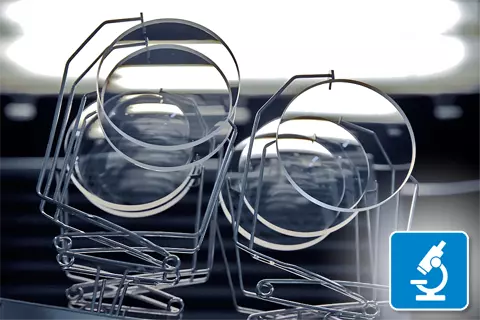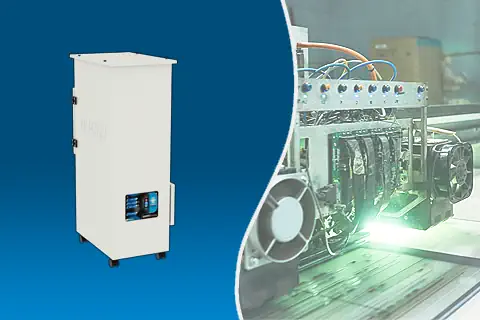Optical Labs
Overview
 Optical labs manufacture lenses used for eyewear such as glasses and contacts based on a prescription from an optometrist. An integral part of any eyecare practice, an optical lab will select the appropriate lens blank that best matches the given prescription. The lab will then cut, grind and polish the lens to meet the prescription and fit the frames. Optical labs are either located in a retail location, an ophthalmologist office or a separate wholesale lab.
Optical labs manufacture lenses used for eyewear such as glasses and contacts based on a prescription from an optometrist. An integral part of any eyecare practice, an optical lab will select the appropriate lens blank that best matches the given prescription. The lab will then cut, grind and polish the lens to meet the prescription and fit the frames. Optical labs are either located in a retail location, an ophthalmologist office or a separate wholesale lab.
Workers in an optical lab face a number of health dangers each day due to occupational dust and fumes. Long-term exposure to these toxins can lead to serious health consequences including cancer. The most common applications used by optical labs that produce airborne toxins include:
- Grinding
- Polishing
- Laser Engraving
- Anti-Glare Coating
- Finishing (Beveling, Edging)
Air Quality Challenges
Grinding
Optical labs use grinding applications at the beginning stage of the production process. A lab technician will choose the appropriate lens blank based on the prescription received from the optometrist. Made from a lightweight polycarbonate material, the front of the lens blank already comes with the correct optical power and is covered in a protective plastic. A metal block is created and secured to the plastic to hold the lens blank in place while the back is grinded inside a computer numeric control (CNC) machine where technicians can input the exact measurements required.
Grinding in optical labs creates polycarbonate and plastic dusts that are dangerous if inhaled. These dusts contain microparticles of plastic that can become embedded deep into the lungs of workers and cause a range of adverse health effects. Coughing, infections, lung disease and pulmonary dysfunction as well as cancer are all caused by long-term exposure to the grinding dust found in optical labs.
Polishing
After grinding, the technicians will use polishing applications to refine the lens and remove any remaining rough circles. Using abrasive sandpaper and polishing compounds such as water, aluminum oxide and polymers, the technicians will polish the lens to maintain the correct shape and a smoother surface. The metal block and protective plastic is also removed at this stage of the manufacturing process. The lens is later cleaned with a 15 step chemical bath.
Like grinding, polishing produces hazardous dust and microparticles. These occupational dusts can mix with polishing compounds and water to create an airborne mist. If inhaled, these mists can lead to a number of adverse health effects often concerning the lungs. Eye and skin irritation may also result.
Laser Engraving
A laser cutting process that produces permanent marks on objects, laser engraving uses a high heat laser to cut into a lens to create a cavity, imprint or mark. In an optical lab, laser engraving is used for all progressive lenses and for specialty work. Some labs will also engrave the company logo or the index of refraction on the lens. Usually these types of marks will be removed in the final stages of lens crafting.
The process of laser engraving produces heavy odors as well as occupational dust and fumes. To reduce exposure and protect worker health, capturing dust and fumes at source is a must. Implementing engineered controls such as laser fume extractors can be highly effective in eliminating indoor pollution and maintaining clean air in the workplace.
Anti-Glare Coating
Once the polishing stage is complete, technicians will place the lenses in an oven to remove any impurities. They will then apply a coating on both sides to reduce the glare on the lens that contains materials such as silicon oxide, titanium oxide or zirconium oxide. This application requires a clean room, free of particulate and other contaminants so that a high quality coating is achieved.
The metals and chemicals used during the anti-glare coating process may adversely affect the respiratory tract if inhaled. Both titanium and zirconium oxide have been known to be respiratory irritants. Titanium oxide is of particular concern as it can cause nausea, dyspnea, and even metal fume fever. Developing rapidly after exposure, symptoms of metal fume fever include fever, myalgia, chills, chest pain, cough, metallic taste, headaches and malaise. More serious cases of the disease can result in shock, collapse, convulsions, shortness of breath, yellow eyes or yellow skin, rash, vomiting, watery or bloody diarrhea, low or high blood pressure.
Finishing (Beveling, Edging)
The final stage of the process includes the finishing applications beveling and edging. Using an edge grinder, lab technicians will cut, shape and bevel the edges of the lens to fit into the eyeglass frame.
Like polishing and grinding, beveling and edging create airborne dust and particulates that pollute indoor air. Exposure to these toxic dusts can lead to a number of adverse health effects often concerning the lungs. Other organs remain at risk as well as these dusts can dissolve in the bloodstream and travel throughout the body. Damage may be seen in the liver, kidneys and even brain.
Solutions for Optical Labs
Dust Collectors

SPH-Mini
Low-Profile Dust Collector
Low-profile, light duty collector with a versatile filtration system which allows for disposable bag, HEPA cartridge and gas phase filter.
Get Product Details
JetStream
Compact Dust Collector
Featuring a compact, space-saving design with a 2-stage filtration system (antimicrobial bag filter and certified HEPA filter). Whisper-quiet performance.
Get Product Details
JetStream WideBody
Compact Dust Collector
Includes all the benefits and features of our JetStream Compact Dust Collector with increased dust collection storage capacity.
Get Product Details
JetStream TallBoy
Compact Dust Collector
Ideal for fine dust and particles featuring a 2-stage filtration system. Compact, space-saving design available with your choice of infinity or brushless motor.
Get Product Details
iVAC Single
Self-Cleaning HEPA Dust Collector
Efficient debris removal system featuring a single infinity or brushless high-speed motor with front-facing digital (iSeries) control panel.
Get Product Details
iVAC Twin
Self-Cleaning HEPA Dust Collector
High-performance debris removal system featuring dual infinity or single brushless high-speed motors with front-facing digital (iSeries) control panel.
Get Product DetailsFume Extractors

SPH 400 Series
Heavy Odor/Duty Fume Extractors
Compact and portable, the SPH 400 Fume Extractor series is designed for heavy duty laser applications.
Get Product Details
SPH 800 Series
Heavy Odor/Duty Fume Extractors
Featuring multi-stage filtration system with HEPA, the SPH 800 Fume Extractor series is ideal for heavy duty laser applications.
Get Product Details
CSA 600 Series
Heavy Odor/Duty Fume Extractors
Eliminate heavy odors and fumes generated by laser applications with the CSA 600 Fume Extractor series.
Get Product Details